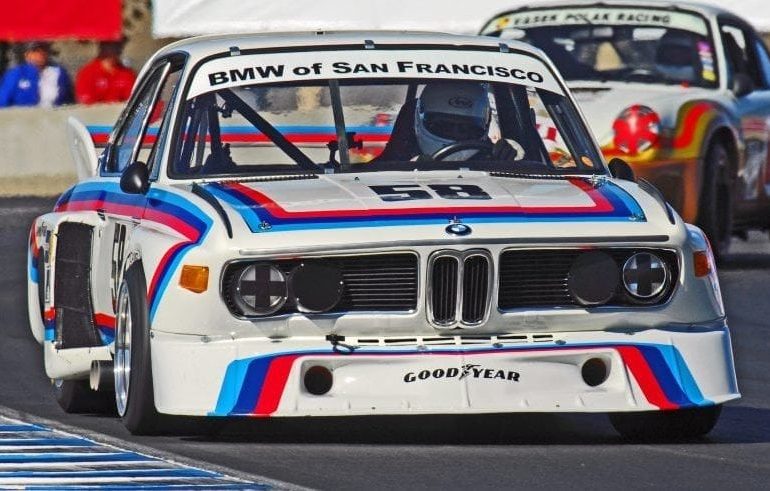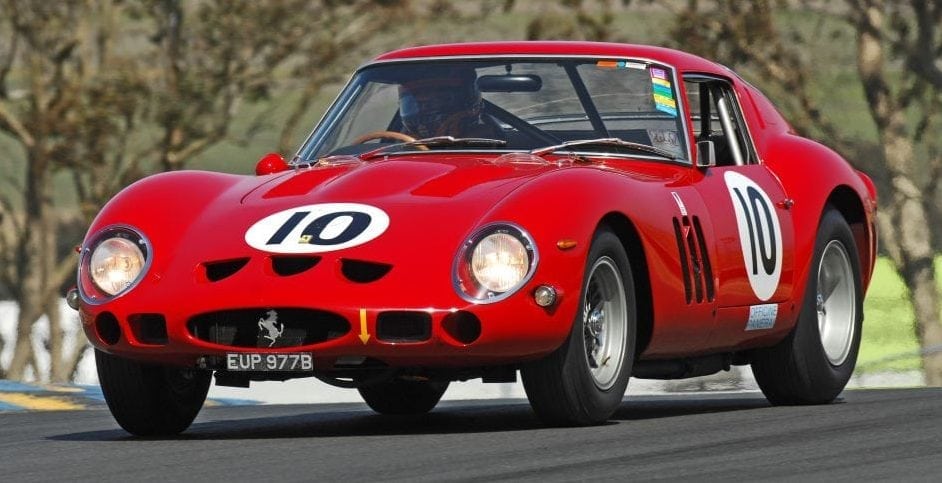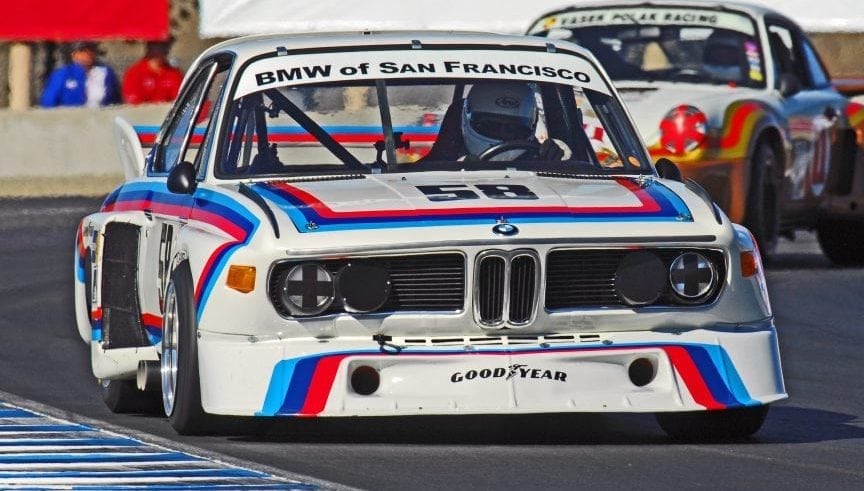Over two-liter Grand Touring cars have always had a place to compete within the ever-changing regulations of international motorsports; the World Sports Car Championship from 1953-1961, the Speedworld Challenge from 1962-1963, and the International Championship of Makes from 1972-1981. This included racing in the great endurance races such as the 24 Hours of Le Mans, the 1000 Kilometers of Nürburgring, Spa and Monza, and the Targa Florio. Aston Martin, Ferrari, Jaguar, Porsche and Ford (by backing Carroll Shelby with the Cobra), all designed very lightweight, successful competition cars to compete in the GT category. In the USA these cars raced in the SCCA and the USRRC.
Today, GT cars qualify to race in many great historic events such as the Tour (de France) Auto, Tour of Spain and Targa Florio because they are dual-purpose race and street cars. They also qualify for the Le Mans 24 Hour Classic and, in the USA, the Monterey Historics and all other race events and tours. Due to their technology, great designs, event eligibility and low production numbers, GT cars have steadily been increasing in value.
Additionally, there was also the popular American series for racing “Sedans,” the Trans-Am Championship, which started in 1966 and, for the purposes of this guide, goes through 1972. This was exciting racing with all of the big American manufacturers involved.
Today, there is a historic Trans-Am group that is always a crowd pleaser. These cars have also proven their worth and have been increasing in value, with buyers paying a premium for team cars with history.
| Make | Model | Level III | Level II | Level I |
| AMC Javelin |
‘68-’72 Trans Am Team |
$700,000 | $800,000 | $900,000 |
|
‘69-’71 Trans Am Independent |
$150,000 | $175,000 | $250,000 | |
| Aston Martin | DB2 | $225,000 | $325,000 | $475,000 |
| DB4 GT | $2,000,000 | $2,500,000 | $3,000,000 | |
| DB4 GT Zagato | $8,000,000 | $9,000,000 | $10,000,000 | |
| Austin-Healey | 100 M | $100,000 | $150,000 | $175,000 |
| 100 S | $700,000 | $850,000 | $1,000,000 | |
| 100-6 MM | $65,000 | $85,000 | $110,000 | |
| 3000 | $60,000 | $80,000 | $110,000 | |
| Bizzarrini | 5300 Strada | $700,000 | $800,000 | $900,000 |
| BMW | 3.0CSL Group 2 | $600,000 | $800,000 | $1,000,000 |
| 3.5CSL M49 | $1,500,000 | $1,800,000 | $2,000,000 | |
| Chevrolet Camaro |
‘67-’71 Trans Am Team Penske |
$800,000 | $875,000 | $950,000 |
|
‘66-’70 Trans Am Independent |
$175,000 | $175,000 | $250,000 | |
| Chevrolet Corvette | Greenwood 1974-1977 | $300,000 | $400,000 | $600,000 |
| BFG 1968-1969 | $750,000 | $825,000 | $900,000 | |
| J.G. 1968-1969 | $700,000 | $750,000 | $850,000 | |
| Chevrolet | ‘56-’62 Corvette | $50,000 | $75,000 | $125,000 |
| ‘63-’67 Corvette | $50,000 | $100,000 | $150,000 | |
| ‘68-’72 Corvette | $50,000 | $100,000 | $150,000 | |
| Cobra | 289 Team Comp | $2,000,000 | $2,200,000 | $2,500,000 |
| 289 Ind. Comp | $800,000 | $1,000,000 | $1,300.000 | |
| 289 USRRC | $2,500,000 | $2,700,000 | $3,000,000 | |
| 289 FIA | $3,500,000 | $4,000,000 | $4,500,000 | |
| 289 Daytona Coupe | $8,000,000 | $9,000,000 | $10,000,000 | |
| 427 S/C | $2,000,000 | $2,200,000 | $2,500,000 | |
| Dodge Challenger |
‘70-’71 Trans Am Team |
$600,000 | $650,000 | $750,000 |
|
‘70-’71 Trans Am Independent |
$150,000 | $175,000 | $250,000 | |
| Ferrari | 250 GT TDF | $8,000,000 | $10,000,000 | $12,000,000 |
| 250 GT LWB Alloy CA Spyder | $12,000,000 | $14,000,000 | $16,000,000 | |
| 250 GT SWB Alloy CA Spyder | $16,000,000 | $18,000,000 | $20,000,000 | |
| 250 GT SWB Alloy Comp | $10,000,000 | $12,000,000 | $14,000,000 | |
| 250 GTO Series I II | $40,000,000 | $45,000,000 | $50,000,000 | |
| 330 LMB | $30,000,000 | $35,000,000 | $40,000,000 | |
| 250/275 LM | $12,000,000 | $15,000,000 | $17,000,000 | |
| 275 GTB Comp | $3,000,000 | $3,500,000 | $4,000,000 | |
| 275 GTB-C Comp | $6,000,000 | $7,000,000 | $9,000,000 | |
| 365 GTB4 Comp | $3,000,000 | $4,000,000 | $4,500,000 | |
|
Ford Shelby Mustang Notch Back |
Trans-Am ‘66-’68 Team | $200,000 | $300,000 | $350,000 |
| Trans-Am ‘66-’68 Independent | $125,000 | $150,000 | $200,000 | |
| Ford Mustang Boss 302 |
Trans-Am ’69-‘72 Team |
$700,000 | $800,000 | $900,000 |
|
Trans-Am ’69-‘72 Independent |
$150,000 | $175,000 | $250,000 | |
| Ford | Capri Group 2 | $300,000 | $350,000 | $400,000 |
| Griffith | 200/400 Series | $50,000 | $75,000 | $100,000 |
| Iso Grifo | A3C Corsa | $1,500,000 | $2,000,000 | $2,500,000 |
| C-Type | $4,000,000 | $5,000,000 | $6,000,000 | |
| D-Type | $6,000,000 | $10,000,000 | $20,000,000 | |
| Jaguar | XKSS | $8,000,000 | $10,000,000 | $12,000,000 |
| XK120 | $100,000 | $125,000 | $175,000 | |
| XK120 Alloy | $350,000 | $425,000 | $500,000 | |
| XKE Lightweight | $6,000,000 | $7,000,000 | $8,000,000 | |
| Ligier | JS1 | $125,000 | $150,000 | $175,000 |
| Ligier | JS2 | $400,000 | $450,000 | $500,000 |
| Plymouth Barracuda | ‘70-’71 Trans Am Team | $500,000 | $600,000 | $700,000 |
| ‘70-’71 Trans Am Independent | $125,000 | $175,000 | $250,000 | |
| Pontiac Firebird | ‘70-’71 Trans Am Team | $500,000 | $600,000 | $700,000 |
| ‘70-’71 Trans Am Independent | $125,000 | $175,000 | $250,000 | |
| Porsche | 911 ST | $1,200,000 | $1,600,000 | $2,000,000 |
| 911 RS 2.7 Lightweight | $700,000 | $900,000 | $1,200,000 | |
| 911 RSR 2.8/3.0 | $1,200,000 | $1,600,000 | $2,000,000 | |
| Shelby | GT350 ’65 | $225,000 | $275,000 | $325,000 |
| GT350 R ’65 | $700,000 | $800,000 | $900,000 | |
| Sunbeam | Tiger 260/289 | $90,000 | $110,000 | $135,000 |
1962 Ferrari 250 GTO
Ferrari S.P.A. of Maranello, Italy, was at the height of racing success in 1961, having won the Formula One World Championship as well as the Le Mans 24 Hours.
Ferrari had dominated the early years of the World Sports Car Championship from its start in 1953, winning the Manufacturer’s Championship seven out of its first nine years. The championship was going to change for 1962, so what type of racing car would Ferrari’s brilliant engineers create?
The 250 GTO project was started by Ferrari’s head engineer Giotto Bizzarrini who had done the 250 SWB. The body was designed by Sergio Scaglietti. When Bizzarrini left Ferrari, the GTO project was taken over by Mauro Forghieri. The GTO had a 2.0-liter V-12 producing 300-plus bhp. A newly designed 5-speed gearbox, a hand-welded tubular frame, front A arm suspension, a live rear axle, four-wheel disc brakes, Borrani wire wheels, and a stunning all-aluminum body.
The FIA rules mandated that 100 cars be built for homologation into the GT category. So, 36 Series One and 3 Series Two GTOs were built. GTO stood for Grand Tourismo Omologato and this new GT version of the 250 SWB was an immediate success at its debut race—the 1962 Sebring 12 Hour where it placed 2ndoverall. The 250 GTO went on to win the World Manufacturer’s Championship in 1962-1963 and 1964. Ferrari’s sports car dominance was to continue with the GTO. Today, the GTO is considered one of the “greatest Ferraris of all time,” and is one of the most valuable cars of all time.
1974 BMW CSL “Batmobile”
The BMW factory in Munich was becoming more involved in motor sports by the early 1970s and was determined to build a contender for Group 2, Group 5, and IMSA Competition. The BMW competition department built a small batch of lightweight CSL racing cars. They were called the “Batmobile” because of the fender flares, front spoiler, and large rear wing.
The factory M49 engine was a 3.5-liter in-line six-cylinder with 4 valves per cylinder (24 valve), 30-degree angle cylinder head, and slide throttle fuel injection producing 450 bhp plus. The BMW factory built and raced less than ten of these M49 cars. When BMW Motorsports stopped racing in house, they built another batch of cars for a total of 29 and supplied them to Team Luigi in Belgium and Schnitzer and Alpina in Germany. The Group 2 car had a 12-valve, 3.2-liter engine for racing in the Deutsche Rennsport Meisterschaft. The CSL was successful at the Sebring 12 Hour, where it won 1stplace overall in 1975 and the Le Mans 24 Hour where it ran as a Group 5 car and finished in the top 10 in 1976. Factory drivers were Ronnie Peterson, Hans Stuck, Brian Redman, and other top stars of the day. A 3.5-liter, 24-valve, M49 spec factory car is a rare car and a thrill to watch at speed tussling with a Porsche RSR or Ford Capri RS. This car is certainly rarer than the more common RSR.
Criteria Used For Assessing Valuations for this Guide:
- Degree of Originality
- Overall Condition, Restoration
- Technology, Design, Coachbuilder
- Production Numbers/Rarity
- Competition History
- Ownership History, Documentation
- Modern Event Eligibility
Regional Variances
The prices stated in this guide are based on U.S. values. The values of historic racing cars can vary as much as 25%-35% in other countries, depending on local market appeal, currency rates, import duties, and VAT. Most of the time, we are able to document known sales or closed escrows, as they say in real estate. When this is not possible, a logical estimate of the car’s value is given, based on its sales history and relationship to cars of its type.
The prices stated in this guide are based on U.S. values. The values of historic racing cars can vary as much as 25%-35% in other countries, depending on local market appeal, currency rates, import duties, and VAT.
LEVEL |
VALUATION CATEGORIES |
|---|---|
I |
The best combination of all criteria. |
II |
Satisfies mid-range of criteria. |
III |
In need of restoration. Meets only a few points of criteria |






